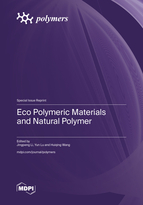Eco Polymeric Materials and Natural Polymer
A special issue of Polymers (ISSN 2073-4360). This special issue belongs to the section "Biomacromolecules, Biobased and Biodegradable Polymers".
Deadline for manuscript submissions: closed (30 July 2022) | Viewed by 64374
Special Issue Editors
Interests: bamboo; rattan; nanomaterials; catalytic reactor; green chemistry; photocatalysis; antimicrobial coatings; water treatment
Special Issues, Collections and Topics in MDPI journals
Interests: wood; cellulose; lignocellulose; nanofiber; aerogel; cell wall
Special Issues, Collections and Topics in MDPI journals
Special Issue Information
Dear Colleagues,
With the increasing concern regarding the undesirable environmental and socioeconomic consequences of petrochemicals and limited fossil resources, biomass, bio-based polymers, and other renewable natural resources have increasingly become alternatives for the production of functional materials. Natural biomass, such as wood, bamboo, rattan, cellulose, bacterial cellulose, lignin, hemicellulose, chitin, alginate, silk, fibroin, starch, protein, collagen, gelatin, natural rubber, and their modified derivatives/composites, have been widely consumed for the preparation of bioplastics/biorubber in the form of film/member/hydrogel/foam/aerogels/fibers for various applications. Biobased synthetic polymers such as polyester, PLA,PHA, PBAT, PC, PBS, polyurethane, and so on can be derived from a variety of molecular biomasses such as straw glucose, plant oils, fatty acids, furan, terpenes, rosin acids, and amino acids. The use of such environmentally friendly or “green” polymer materials can avoid the dependence on petroleum resources and reduce carbon emissions. Additionally, the green solvent/process/technology for polymer and polymer for capturing pollution also contribute to the aim of global green and low-carbon transformation.
This Special Issue titled “Eco-Polymeric Materials and Natural Polymer” focuses on low-carbon chemistry, such as the utilization of biomass and transformation of renewable biomass-derived platform chemicals into functional polymeric materials. Innovative approaches as well as advanced applications of eco-polymeric materials and natural polymer in different fields, such as energy, electronics, the environment, biomedical, biomaterial, and bio-adhesive, are welcome in this Special Issue. All the methods of modification treatments for improving the durability of polymers are also welcome. We are delighted to invite you to contribute to this Special Issue your work in the form of full research articles, letters, communications, or reviews.
Dr. Jingpeng Li
Dr. Yun Lu
Dr. Huiqing Wang
Guest Editors
Manuscript Submission Information
Manuscripts should be submitted online at www.mdpi.com by registering and logging in to this website. Once you are registered, click here to go to the submission form. Manuscripts can be submitted until the deadline. All submissions that pass pre-check are peer-reviewed. Accepted papers will be published continuously in the journal (as soon as accepted) and will be listed together on the special issue website. Research articles, review articles as well as short communications are invited. For planned papers, a title and short abstract (about 100 words) can be sent to the Editorial Office for announcement on this website.
Submitted manuscripts should not have been published previously, nor be under consideration for publication elsewhere (except conference proceedings papers). All manuscripts are thoroughly refereed through a single-blind peer-review process. A guide for authors and other relevant information for submission of manuscripts is available on the Instructions for Authors page. Polymers is an international peer-reviewed open access semimonthly journal published by MDPI.
Please visit the Instructions for Authors page before submitting a manuscript. The Article Processing Charge (APC) for publication in this open access journal is 2700 CHF (Swiss Francs). Submitted papers should be well formatted and use good English. Authors may use MDPI's English editing service prior to publication or during author revisions.
Keywords
- advanced multiscale processing methods
- polymer synthesis and reactions
- polymers for advanced application
- enhanced durability of polymers
- biomass-derived materials
- biodegradable polymers
- eco-polymer composites
- natural polymers and derivatives
- nanotechnology for polymers
- green solvent/process/synthesis of polymers
- biomedical polymers
- polymers for CO2 capture
- polymers for capturing pollution
Related Special Issue
- Eco-Friendly Supramolecular Polymeric Materials in Polymers (23 articles)









